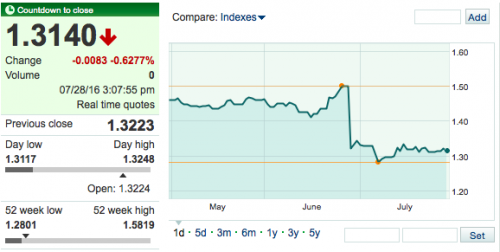
Note: This is Part 2 of a series of stories on the multitude of effects that the Brexit is having on global real estate markets now and in the future.
As mentioned in Part 1, the British public’s decision to terminate the U.K.’s membership in the European Union (EU), commonly known as Brexit, has been the most significant financial and economic news story in 2016. With financial investors in shock over the decision, global equity markets saw the largest two-day selloff in almost 12 months, although stock levels did return to normalcy within a few days. While real estate markets do not experience sharp, immediate fluctuations in reaction to economic and financial events, we can nonetheless examine how the U.K.’s decision to leave the EU could impact commercial real estate markets within the United States for better or worse.
Within the U.K., real estate transactions have remained unfazed by the historic vote. However, there have been rumblings of investors seeking to reduce exposure to or fully divest from British commercial real estate; thereby leading to a slow down in price appreciation. Many believe the effects of the decision could begin surface in the real estate sector come the first quarter of 2017.
Increased Interest in US Real Estate
If investors, particularly institutional investors, chose to reconfigure their portfolios, capital could flow from British real estate, previously seen as low risk, into American gateway markets. As mentioned in a previous post about the FOMC decision, The Fed and Real Estate – Beyond the June FOMC Meeting, to maintain the federal funds rate at ¼ to ½ percent, the United States currently presents a safe-haven environment for low-risk profile investors.
With New York City real estate ranking as the most valuable, commercial real estate activity within the five boroughs could stand to experience greater investment. Currently, London real estate prices (on a per-meter basis) are nearly double the values seen in New York City. If capital flows from foreign and domestic investors flood into New York City, this could lead Gotham to a superior position to British real estate in the years to follow. Other cities besides New York City stand to gain from the diversion of capital flows from the U.K. to the U.S. After all, there is only one true gateway-level market in the U.K. (London), but there are several in the United States besides New York City. Other cities such as Los Angeles, San Francisco, and Miami are in a position to receive investment that would normally have gone to assets in London.
Adding to the theory that United States’ gateway markets could see a substantial influx of capital, the U.S. multifamily sector saw $16.3 billion of foreign investment in 2015 based on data from Real Capital Analytics (RCA). Of those investment dollars, $2 billion was sourced from British investors. An increase of investment from that spigot of capital rests squarely on the uncertainty surrounding the Brexit decision. As time progresses and the U.K.’s future relationship with the E.U. becomes clearer, the positive effects from Brexit on the U.S. real estate market will depend greatly on the uncertainty within the British and E.U. markets. If uncertainty increases, then the trend of investors looking for the safe haven of U.S. commercial real estate should increase.
Furthermore, the global haven of United States real estate is highlighted in the following RCA data:
- Total global investment in U.S. CRE grew to $94.1 billion in 2015
- The previous figure constitutes a 576 percent increase from the $14.1 billion invested in 2010, when adjusted for inflation
- Annualized investment capital year-to-date, as of June 2016, is projected to reach $67.6 billion
US Real Estate Investment Remains Status Quo
Adding to the complexity of foreign investors’ decision to invest in U.S. commercial real estate is the FOMC possibly raising the cost of capital via increasing rates and the results of the US Presidential race. With the decision of U.K. to leave the E.U., the risk of other countries increasing trade barriers pervades. The emerging theme of nationalism over globalism in Western countries has persisted within the US Presidential race, particularly from the conservative right. This and a potential increase in the cost of capital has placed would-be investors on the sidelines.

On the other side of the demand equation, the U.K. comprises the single largest cumulative foreign investment in the U.S. With the possibility of continued devaluation of the British pound versus the U.S. dollar, the purchasing power of British investors could decrease. If the FOMC holds true to its plan of raising rates late in 2016 or early 2017, then the largest foreign investor in U.S. real estate would be prone to remain on the sidelines with their capital. The possibility of the largest foreign investor in U.S. CRE not being able to continue its annual investment capital stream is not an ideal situation for the sector.
Conclusion
Although the jury will be out until possibly the first quarter of 2017, U.S. CRE will need favorable winds from continued FOMC dovish rates, a White House policy that favors globalization, and continued foreign investment. The possibility of continued low cap rates remains high, even as Kansas City Fed President Esther George remains the lone dissenter to elevating rates in the coming months. However, the FOMC did make mention of the Brexit decision in their June 2016 meeting statement, claiming that it could change their view of when to raise the federal funds rate. With the possibility of low cap rates, U.S. CRE could continue to see increased prices in gateway markets, along with greater capital flows.
Robert Lathan is a 2017 MSRE candidate of the Baker Program in Real Estate, concentrating in Real Estate Investments and Finance with a focus on Hotels and Resorts. He is a Senior Editor of the Baker Program Real Estate Review.
For more information on the Baker Program in Real Estate, please visit: www.baker.realestate.cornell.edu.

